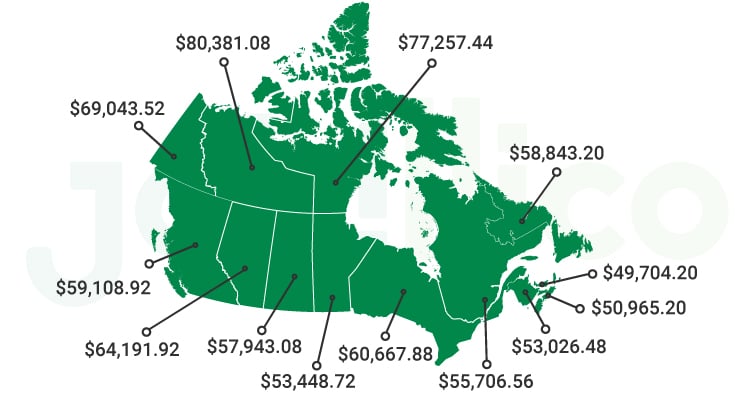The Average Canadian Salary in 2021
 Publié le 23 December 2021
Publié le 23 December 2021
What is the average Canadian salary in 2021? How has the COVID-19 pandemic impacted salaries across the country? Which province offers the highest salary? Which industry has experienced growth during this time? Which sectors experienced a decrease?
A new collection of data released by Statistics Canada highlights wage and salary growth in the different sectors, industries and provinces across the country. By analyzing and reviewing the data, it is possible to answer important questions about the state of the Canadian economy. Knowing the average Canadian salary in 2021 will help people understand the larger trends in their industry, and know the worth of their skills and abilities. It also allows young people and new graduates looking to enter the workforce at such an uncertain time to see areas where their skills will be most highly valued.
The Impact of COVID-19 on the Average Canadian Salary in 2021
The full brunt of the COVID-19 was likely felt in the middle of and towards the end of 2020. The spring of 2021 saw the vaccination program open to the majority of Canadians, allowing for fewer restrictions and more operations during the summer and fall months. The fact that salaries and wages went up in many industries affected by COVID does not mean that the pandemic is in the past, as it clearly is not. The nature of the job market continues to be unpredictable due to the pandemic, and there will likely be different salary breakdowns on a monthly basis as businesses have to react to evolving situations and guidelines.
What Is The Average Canadian Salary in 2021?
As of September 2021, the average Canadian salary in 2021 was $65,773.18 per year for full-time employees across the country. The salary trend is positive, and the majority of Canadian workers are earning more than they did in the previous year. There are differences in average Canadian salary based on province and job sector, which will be explored more below.
Average Canadian Annual Salary by Province and Territory (data from September 2021)

- Newfoundland and Labrador – $58,843.20 (+6.0%)
- Prince Edward Island – $49,704.20 (+8.3%)
- Nova Scotia – $50,965.20 (+5.2%)
- New Brunswick – $53,026.48 (+7.1%)
- Québec – $55,706.56 (+7.7%)
- Ontario – $60,667.88 (+9.3%)
- Manitoba – $53,448.72 (+7.6%)
- Saskatchewan – $57,943.08 (+6.6%)
- Alberta – $64,191.92 (+3.8%)
- British Columbia – $59,108.92 (+10.7%)
- Yukon –$69,043.52 (+11.7%)
- Northwest Territories – $80,381.08 (+3.5%)
- Nunavut – $77,257.44 (-11.6%)
The average Canadian salary in 2021 has increased at a national level, but employees working in different provinces and territories still earn different average annual salaries. The average annual salary remains high in British Columbia, Ontario and Alberta, provinces that are traditionally strong economically.
What may be surprising to some is that the average annual salary in Saskatchewan and Newfoundland and Labrador now exceeds those in Quebec, another traditionally economically strong province. The average Canadian salaries in 2021 in Quebec, Saskatchewan, Newfoundland and Labrador, British Columbia and Ontario are all within $5,000 of each other, demonstrating the resilience of different parts of the Canadian economy.
Similar to 2020, the highest average Canadian salaries in 2021 can be found in Alberta, and the Yukon, the Northwest Territories and Nunavut. These parts of Canada all have strong roots in the energy, mining and energy sectors, which demonstrates the importance these sectors play in the national economy.
The Provinces/Territories with the Highest Rate of Salary Growth
The average Canadian salary and its growth rate differs in each province and territory across the country. There were areas that experienced a large salary growth, increasing by over 8% during the preceding year. The Yukon experienced the highest increase, with the average salary growing by 11.7%. The only other part of Canada to experience more than 10% is British Columbia, with an average salary increase of 10.7%.
- Yukon – +11.7%
- British Columbia – +10.7%
- Ontario – +9.3%
- Prince Edward Island – +8.3%
Almost all provinces and territories experienced an increase in the average annual salary in 2021, with the exception of Nunavut. Employees in Nunavut experienced an 11.06 decrease in their average annual salary, dropping from $87,355.00 to $77,257.44 per year. The good news is that even with this decrease in salary, the average salary in Nunavut in 2021 is still the second highest in the entire country, exceeded only by the Northwest Territories.
- Nunavut – -11.6%
- Northwest Territories – +3.5%
- Alberta – +3.8%
- Nova Scotia – +5.2%
A decrease in salary does not necessarily mean that employees in their areas are paid a low amount. The Northwest Territories and Alberta experienced the second and third lowest salary increase, but are still in the top four in terms of the highest average Canadian salary in 2021.
Average Canadian Annual Salary by Job Sector*
- Accommodation and Food Services – $24,027.64 (+5.0%)
- Administrative and Support – $50,084.32 (+5.7%)
- Arts, Entertainment and Recreation – $37,700.00 (-6.3%)
- Construction – $71,399.64 (+4.4%)
- Education – $61,726.60 (+5.8%)
- Finance and Insurance – $75,977.72 (-1.3%)
- Forestry and Logging – $67,057.12 (+14.2%)
- Health Care and Social Assistance – $51,264.72 (-3.1%)
- Information and Culture Industries – $86,197.80 (+20.3%)
- Management of Companies and Enterprises – $82,704.96 (+10.9%)
- Manufacturing – $62,551.32 (+2.7%)
- Mining, Oil and Gas Extraction – $116,592.84 (+3.1%)
- Professional, Scientific and Technical Services – $80,285.40 (+5.5%)
- Public Administration – $76,752.00 (+1.3%)
- Real Estate (Rental/Leasing) – $63,319.36 (+8.1%)
- Retail – $34.476.00 (-0.1%)
- Transportation and Warehousing – $61,727.64 (+1.2%)
- Utilities – $97,522.36 (-3.9%)
- Wholesale Trade – $70,382.52 (+4.4%)
*data from September 2021
Canadian Industries with the Most Growth
While the average Canadian salary in 2021 has increased, that growth is far from uniform across every job sector. Certain industries have experienced tremendous growth, while others have only seen their average salary increase by a small amount. Knowing the industries experience a high salary growth rate is useful information for job seekers, as it can help them see where their skills will be valued and where they can potentially build a long-term career. Three Canadian industries experience an average salary growth rate of over 10%, with a fourth sector nearing this rate as well.
- Information and Culture Industries – +20.3%
- Forestry and Logging – +14.2%
- Management of Companies and Enterprises – +10.9%
- Real Estate (Rental/Leasing) – +8.1%
The Information and Culture Industries experienced the highest average salary growth by far, increasing by 20.3% from $71,634 in 2020 to $86,197.80 in 2021. This is followed by the Forestry and Logging sector with average salary increasing 14.2% from $58,739.20 in 2020 to $67,057.12 in 2021.
This is good news for employees in the Forestry sector, which had actually experienced an 8.9% salary decrease the previous year. It is also interesting to note that while the average salary in Information and Culture Industries and the Management of Companies and Enterprises sector are in the top five highest overall, the average salary in the Forestry sector remains squarely in the middle despite experiencing the second highest amount of growth.
The Real Estate sector experienced the fourth highest salary increase, down from the second highest growth rate in 2020. This is despite the fact that the Canadian real estate market is the one industry that seems to only increase even with some predictions to the contrary.
Canadian Industries Where the Average Annual Salary has Declined
The average Canadian salary in 2021 has increased, but unfortunately this does not apply to every single job sector. There are five Canadian industries where employees experienced a decrease in their average salary in 2021:
- Arts, Entertainment and Recreation – -6.3%
- Utilities – -3.9%
- Health Care and Social Assistance – -3.1%
- Finance and Insurance – -1.3%
- Retail – -0.1%
The Arts, Entertainment and Recreation sector experienced the biggest decrease, dropping by 6.3% from $40,241.76 in 2020 to $37,700.00 in 2021. This can be attributed to the extremely volatile nature of the industry, with the ability to hold events such as concerts, sports and other gatherings due to necessary pandemic restrictions. Many in the industry found themselves laid off, temporarily or not, or working reduced hours and for limited periods, while dealing with rising rents and insurance costs. The second largest average salary decrease was experienced by the Health Care and Social Assistance sector, despite the important life-saving work being performed.
The Utilities and Finance and Insurance sector also experienced largest decreases in salary, but are still among the highest salaries overall in any Canadian industry. The Retail sector experienced a small decrease of 0.1% – which is further compounded by the average cost of living increase – even though many employees had to deal with unknown and adverse conditions during the pandemic.
The Canadian Job Sectors with the Highest Average Annual Salary
- Mining, Oil and Gas Extraction – $116,592.84
- Utilities – $97,522.36
- Information and Culture Industries – $86,197.80
- Management of Companies and Enterprises – $82,704.96
- Professional, Scientific and Technical Services – $80,285.40
As in 2020, the jobs with the highest average Canadian salary in 2021 are those dealing with energy and natural resources. The Mining Oil and Gas Extraction sector is the only Canadian industry with an average 2021 salary of over $100,000, which speaks to the continued demand for Canadian energy resources despite pandemic-related shipping issues. The Utilities sector also nears the six-figure salary range, despite the previously mentioned growth decrease.
The Information and Culture Industries and Management of Companies and Enterprises sectors both enter the top five overall highest salaries after experiencing tremendous growth in 2021. The Professional, Scientific and Technical Services sector also remained strong, with the specialized skills and abilities possessed by these workers enjoying high demand in 2021.
The Canadian Job Sectors with the Lowest Average Annual Salary
- Accommodation and Food Services – $24,027.64
- Retail – $34.476.00
- Arts, Entertainment and Recreation – $37,700.00
There are three job sectors where the average Canadian salary in 2021 is below $50,000 per year. The Accommodation and Food Services sector has the lowest average salary of any industry at $24,027.64 per year, despite experiencing 5% salary growth over the past year. The Retail and Arts, Entertainment and Recreation sectors also experienced decreases of 0.1% and 6.3% respectively.
All three of these job sectors have been greatly affected by the ongoing pandemic, as they are the first to face restrictions necessary to slow the spread of COVID-19. People in these sectors have faced tremendous challenges over the past year, including pivoting to new ways of serving clients, a sometimes angry customer-base and personal risk due to the pandemic. There were moments of respite as some restrictions were reduced as a result of vaccination and the efforts of health care workers, but it is clear that these sectors require continued support in the coming year.
With the data from Statistics Canada demonstrating that the average Canadian salary in 2021 has increased, it is a good indication for working professionals across the country. There are opportunities in many industries for job seekers entering the job market or people changing careers, with growing average salaries to match the skills they bring to the workplace. Nevertheless, there are certain sectors that have experienced negative growth, and the pandemic will continue to have an impact on all parts of society in 2022.







